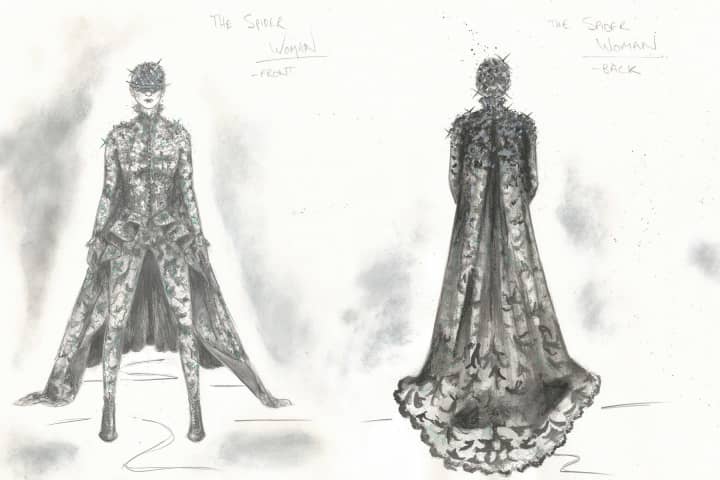John Kander and Fred Ebb’s best-loved works spin musical magic out of sombre histories and bleak settings – Nazism, war, murder and prison in particular. The seven-time Tony Award-winning Kiss of the Spider Woman joins Chicago in a jail cell, but in place of American murderesses are Argentinean political prisoners. While the production's setting remains ambiguous, the political and social reality that inspired Manuel Puig’s original novel is stark: Argentina’s Dirty War.
The war was technically a dictatorship by military junta, ushered in by a coup d’état and characterised by mass state terrorism. It officially began in 1976 (although many of its horrors began earlier than that) and resulted in the disappearance of an estimated 30,000 civilians. The junta kidnapped tens of thousands of its own citizens on suspicion of subversion, usually without legitimate evidence. The majority of those captured never returned home, vanishing without a trace. These ‘desaparecidos’, or disappeared, were predominantly young, politically mobilised supporters of Peronism (the left-wing political movement named after three-time Argentine president Juan Perón) and liberal egalitarianism – artists, academics, teachers, journalists, trade unionists, dissidents and free thinkers. They are known as ‘the disappeared’ because no records of their arrests were ever recorded, nor evidence of their alleged crimes, details of charges laid against them, or proof of their deaths.
‘If there are things that have to be done, you should do them quickly.’ – Henry Kissinger
Over a seven-year period and under the guise of combatting guerrilla warfare that promoted anti-Western and anti-Christian ideals, the junta (known officially as Proceso de Reorganización Nacional, or El Proceso) was able to orchestrate widespread torture, incarceration and the murder of its own people without any regard for the law.[1] Throughout, it received backing from the US government, to the tune of US$170 million, or more.
In June 1976, US Secretary of State Henry Kissinger told the Argentine Foreign Minister, Admiral César Augusto Guzzetti, ‘If there are things that have to be done, you should do them quickly. But you should get back quickly to normal procedures.’[2] Not surprisingly, the junta saw this as carte blanche, and it began organising mass assassinations, including ‘death flights’ where they drugged, chained and flew prisoners over the South Atlantic Sea and disposed of their bodies in waters where their remains could never be recovered. They also stole approximately 500 infants from imprisoned mothers who were either pregnant upon arrest, or became pregnant in prison by rape. These babies were taken and adopted out to military and church families before their birth mothers were disappeared.
Madres de Plaza de Mayo
What the regime didn’t anticipate was the response of the mothers whose children were taken. The Mothers of the Plaza de Mayo (Madres de Plaza de Mayo) started marching in pairs to evade arrest for assembling in groups larger than three. They circled the presidential palace in quiet protest and have not stopped demanding answers for the disappearance of their children ever since. Three of the movement’s founding mothers – Azucena Villaflor de Vincenti, Esther Ballestrino de Careaga and María Eugenia Ponce de Bianco – were abducted and murdered, alongside two French nuns who championed their efforts: Alice Domon and Léonie Duquet. Notwithstanding these murders, and the significant risk posed to their safety, the women continued marching. For three decades they met outside the executive mansion, Casa Rosada, at 3.30pm every Thursday and marched. With placards displaying portraits of their stolen sons and daughters, as well as the dates they vanished, they protested, reminding the government and eventually the whole world that their loved ones would never be forgotten.

In Plaza de Mayo, on 9 and 10 December, 1982. Author: Archivo Hasenberg-Quaretti.
Source: Wikimedia Commons
Within a year of the Madres de Plaza de Mayo’s establishment, their movement had grown by hundreds. Government officials referred to them as ‘las locas’, or mad women, which only bolstered their efforts further. Now 88 years of age, Taty Almeida remembers her son Alejandro, who disappeared when he was just 20. Almeida told The Guardian ‘Of course we were mad. Mad with grief, with impotence. They took a woman’s most precious gift, her child.’[3] The collective suffering of this group became the fuel to ignite their campaign. And in 1978, when Argentina hosted the World Cup in Buenos Aires, the whole planet started paying attention to their pleas for justice. Together, they transferred their agony into rage and over the subsequent decades, they have succeeded in bringing hundreds of the regime’s persecutors before the courts and to justice.
Abuelas de Plaza de Mayo
A branch of the group, Grandmothers of the Plaza de Mayo (Abuelas de Plaza de Mayo), have successfully identified and documented over 256 kidnapped infants, and as of June this year they have reconnected 130 of these stolen children with their biological families.[4] Estela de Carlotto has been the president of the association since 1989, and over a 36-year search she tried desperately to locate the son of her slain daughter, Laura Carlotto. Laura was abducted when she was three months pregnant and kept alive in captivity for the duration of her pregnancy because the devout Catholic officers believed it would be immoral to kill her unborn child. She gave birth in a military hospital and was murdered soon after. In 2015, professional musician Ignacio Hurban, now Ignacio Montoya Carlotto, voluntarily took a DNA test that proved he was Estela de Carlotto’s grandson. The results also confirmed he was the son of murdered musician Walmir Montoya, Laura Carlotto’s secret lover, and thus grandson of 91-year-old Hortensia Montoya. When Ignacio’s grandmothers first spoke on the phone, Estela said ‘Now I understand why my daughter fell in love with your son.’[5]

The Mothers of Plaza de Mayo with Nestor Kirchner, former President of Argentina.
Attribution: Presidencia de la Nación Argentina. Source: Wikimedia Commons
Ignacio told Uki Goñi at The Guardian, ‘Meeting my two grandmothers was the most moving thing… because it was like “Bam, there it is, this is it – we won, we did it, we’re here, seeing each other, talking.” Do you know what it was like hearing those two women talking to each other? The ground shakes when they meet. Two such powerful persons talking about their children, getting to know each other through the love their children had, crying for joy in the midst of this terrible tragedy.’[6]
Since Ignacio was found, 16 others have been reunited with their surviving relatives. Estela Carlotto, now 89 years old, told Goñi, ‘Laura can rest in peace now. I felt Laura said to me: “Mother, mission accomplished.” But there’s so much still to do. I’m going to keep looking for the other missing ones.’
Hope for the future
The military junta ruled the nation until Raúl Alfonsín was democratically elected in December 1983. The new government established the Comisión Nacional sobre la Desaparición de Personas or CONADEP to investigate the crimes against humanity committed throughout the Dirty War. In 1985, the Trial of the Juntas commenced, prosecuting hundreds of military officers for their part in the country’s recent bloody history.
The fight for justice in Argentina continues to this day. Many of the mothers and grandmothers who’ve dedicated their lives to establishing justice for their children and grandchildren are now in their final years of life, and despite their successes they view the global rise of ‘alternative facts’ and ‘fake news’ with an especially personal alarm. But they are also hopeful: today, the republic of Argentina is looking forward to a new era of Peronism, when their president-elect Alberto Fernández takes up his post on 10 December. Fernández is the proud father of a drag icon, and has vowed to legalise abortion, which would make the predominantly Roman Catholic country the first in Latin America to pass the bill. The shifting balance of power in the region will hopefully see a new reign of peace and egalitarianism for the people of Argentina; a cause for which so many desaparecidos gave their lives.
Kiss of the Spider Woman is on at The Southbank Theatre, The Sumner, until 28 December.
[1]Osorio, Carlos, On 30th Anniversary of Argentine Coup: New Declassified Details on Repression and U.S. Support for Military Dictatorship. The National Security Archive. https://nsarchive2.gwu.edu/. Posted March 23, 2006. Retrieved November 19, 2019.
[2]Osorio, Carlos and Costar, Kathleen, Kissinger to the Argentine Generals in 1976 "If there are things that have to be done, you should do them quickly”, The National Security Archive. https://nsarchive2.gwu.edu/. Posted August 27, 2004. Retrieved November 19, 2019.
[3] Goñi, Uki, ‘40 years later, the mothers of Argentina’s 'disappeared' refuse to be silent’, https://www.theguardian.com/world/2017/apr/28/mothers-plaza-de-mayo-argentina-anniversary, Posted 28 April, 2017. Retrieved 13 November, 2019
[4] Buenos Aires Times, ‘Grandmothers of Plaza de Mayo identify 130th missing grandchild of long search’, https://www.batimes.com.ar/news/argentina/grandmothers-of-plaza-de-mayo-identify-130th-missing-grandchild-of-long-search.phtml Posted 10 June, 2019. Retrieved 13 November, 2019
[5] Goñi, Uki, ‘A grandmother’s 36-year hunt for the child stolen by the Argentinian junta’, https://www.theguardian.com/world/2015/jun/07/grandmothers-of-plaza-de-mayo-36-year-hunt-for-stolen-child, Posted 7 June 2015. Retrieved November 20, 2019
[6] Goñi, Uki, ‘40 years later, the mothers of Argentina’s 'disappeared' refuse to be silent’, https://www.theguardian.com/world/2015/jun/07/grandmothers-of-plaza-de-mayo-36-year-hunt-for-stolen-child, Posted April 28, 2017. Retrieved November 13, 2019
Published on 25 November 2019





